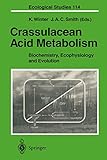Crassulacean acid metabolism biochemistry, ecophysiology and evolution K. Winter, J.A.C. Smith (Eds.)
Tipo de material: Libro
impreso(a)
Idioma: Inglés Series Detalles de publicación: Berlin, Heidelberg, Germany Springer-Verlag 1996Descripción: xxix, 449 páginas fotografías, ilustraciones 24 centímetrosISBN:
Libro
impreso(a)
Idioma: Inglés Series Detalles de publicación: Berlin, Heidelberg, Germany Springer-Verlag 1996Descripción: xxix, 449 páginas fotografías, ilustraciones 24 centímetrosISBN: - 3642790623
- 9783642790621
- 583.72 C7
Incluye bibliografía e índice: páginas 437-449
Crassulacean acid metabolism (CAM) represents one of the best-studied metabolic examples of an ecological adaptation to environmental stress. Well over 5 % of all vascular plant species engage in this water-conserving photosynthetic pathway. Intensified research activities over the last 10 years have led to major advances in understanding the biology of CAM plants. New areas of research reviewed in detail in this book include regulation of gene expression and the molecular basis of CAM, the ecophysiology of CAM plants from tropical environments, the productivity of agronomically important cacti and agaves, the ecophysiology of CAM in submerged aquatic plants, and the taxonomic diversity and evolutionary origins of CAM. Español


